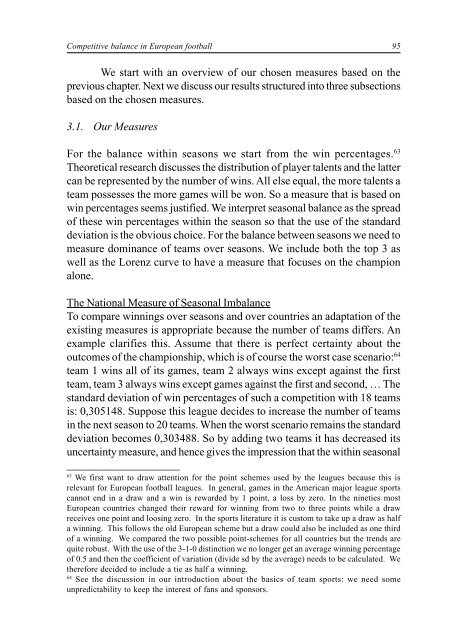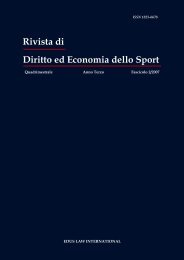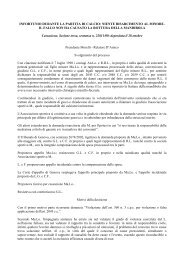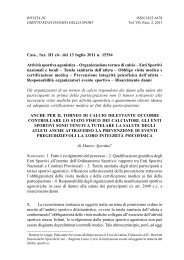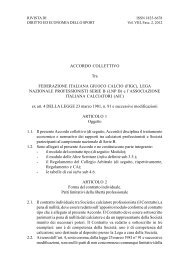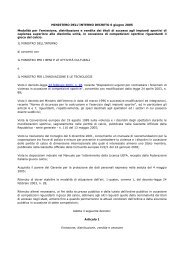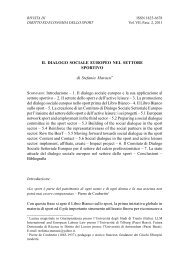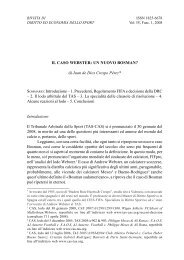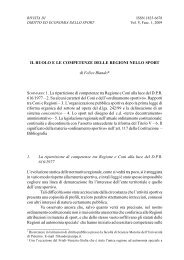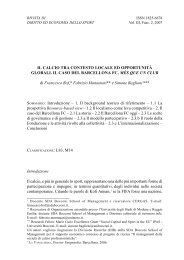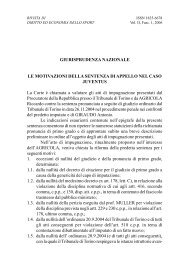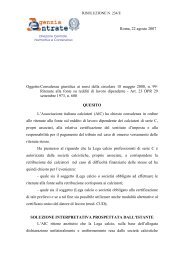Rivista di Diritto ed Economia dello Sport - Rdes.it
Rivista di Diritto ed Economia dello Sport - Rdes.it
Rivista di Diritto ed Economia dello Sport - Rdes.it
You also want an ePaper? Increase the reach of your titles
YUMPU automatically turns print PDFs into web optimized ePapers that Google loves.
Compet<strong>it</strong>ive balance in European football 95We start w<strong>it</strong>h an overview of our chosen measures bas<strong>ed</strong> on theprevious chapter. Next we <strong>di</strong>scuss our results structur<strong>ed</strong> into three subsectionsbas<strong>ed</strong> on the chosen measures.3.1. Our MeasuresFor the balance w<strong>it</strong>hin seasons we start from the win percentages. 63Theoretical research <strong>di</strong>scusses the <strong>di</strong>stribution of player talents and the lattercan be represent<strong>ed</strong> by the number of wins. All else equal, the more talents ateam possesses the more games will be won. So a measure that is bas<strong>ed</strong> onwin percentages seems justifi<strong>ed</strong>. We interpret seasonal balance as the spreadof these win percentages w<strong>it</strong>hin the season so that the use of the standarddeviation is the obvious choice. For the balance between seasons we ne<strong>ed</strong> tomeasure dominance of teams over seasons. We include both the top 3 aswell as the Lorenz curve to have a measure that focuses on the championalone.The National Measure of Seasonal ImbalanceTo compare winnings over seasons and over countries an adaptation of theexisting measures is appropriate because the number of teams <strong>di</strong>ffers. Anexample clarifies this. Assume that there is perfect certainty about theoutcomes of the championship, which is of course the worst case scenario: 64team 1 wins all of <strong>it</strong>s games, team 2 always wins except against the firstteam, team 3 always wins except games against the first and second, … Thestandard deviation of win percentages of such a compet<strong>it</strong>ion w<strong>it</strong>h 18 teamsis: 0,305148. Suppose this league decides to increase the number of teamsin the next season to 20 teams. When the worst scenario remains the standarddeviation becomes 0,303488. So by ad<strong>di</strong>ng two teams <strong>it</strong> has decreas<strong>ed</strong> <strong>it</strong>suncertainty measure, and hence gives the impression that the w<strong>it</strong>hin seasonal____________________63We first want to draw attention for the point schemes us<strong>ed</strong> by the leagues because this isrelevant for European football leagues. In general, games in the American major league sportscannot end in a draw and a win is reward<strong>ed</strong> by 1 point, a loss by zero. In the nineties mostEuropean countries chang<strong>ed</strong> their reward for winning from two to three points while a drawreceives one point and loosing zero. In the sports l<strong>it</strong>erature <strong>it</strong> is custom to take up a draw as halfa winning. This follows the old European scheme but a draw could also be includ<strong>ed</strong> as one thirdof a winning. We compar<strong>ed</strong> the two possible point-schemes for all countries but the trends arequ<strong>it</strong>e robust. W<strong>it</strong>h the use of the 3-1-0 <strong>di</strong>stinction we no longer get an average winning percentageof 0.5 and then the coefficient of variation (<strong>di</strong>vide sd by the average) ne<strong>ed</strong>s to be calculat<strong>ed</strong>. Wetherefore decid<strong>ed</strong> to include a tie as half a winning.64See the <strong>di</strong>scussion in our introduction about the basics of team sports: we ne<strong>ed</strong> someunpre<strong>di</strong>ctabil<strong>it</strong>y to keep the interest of fans and sponsors.


